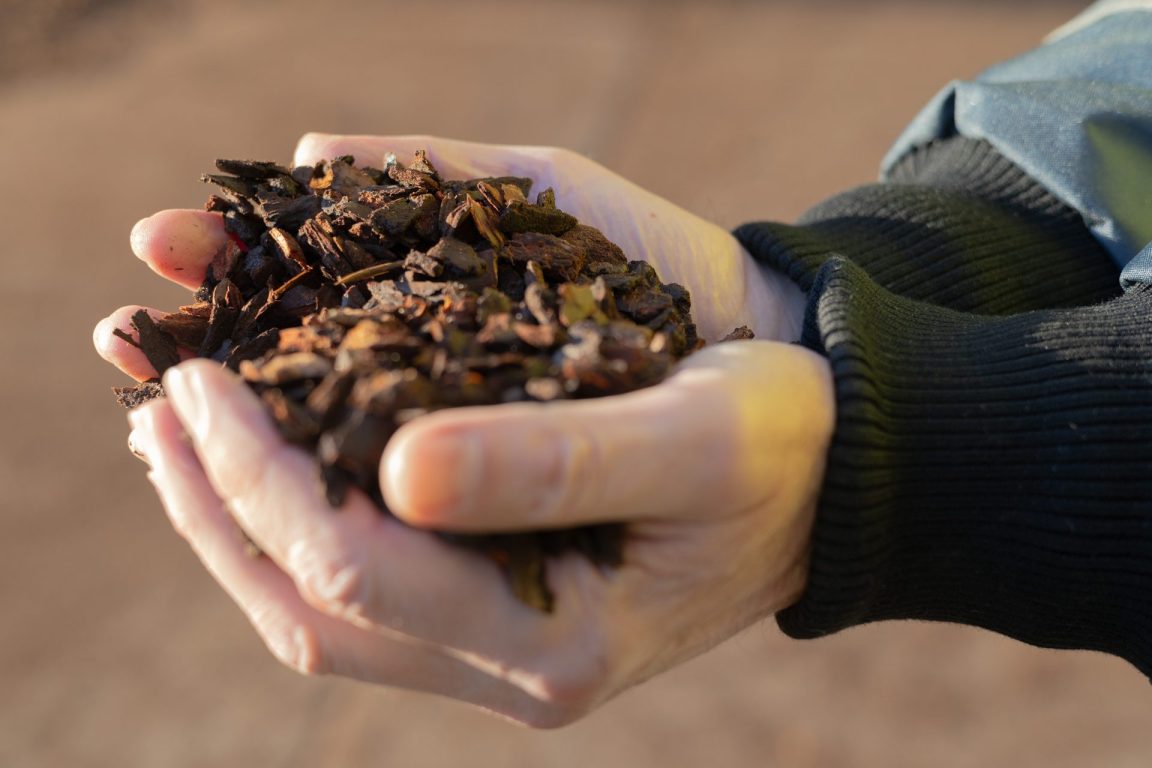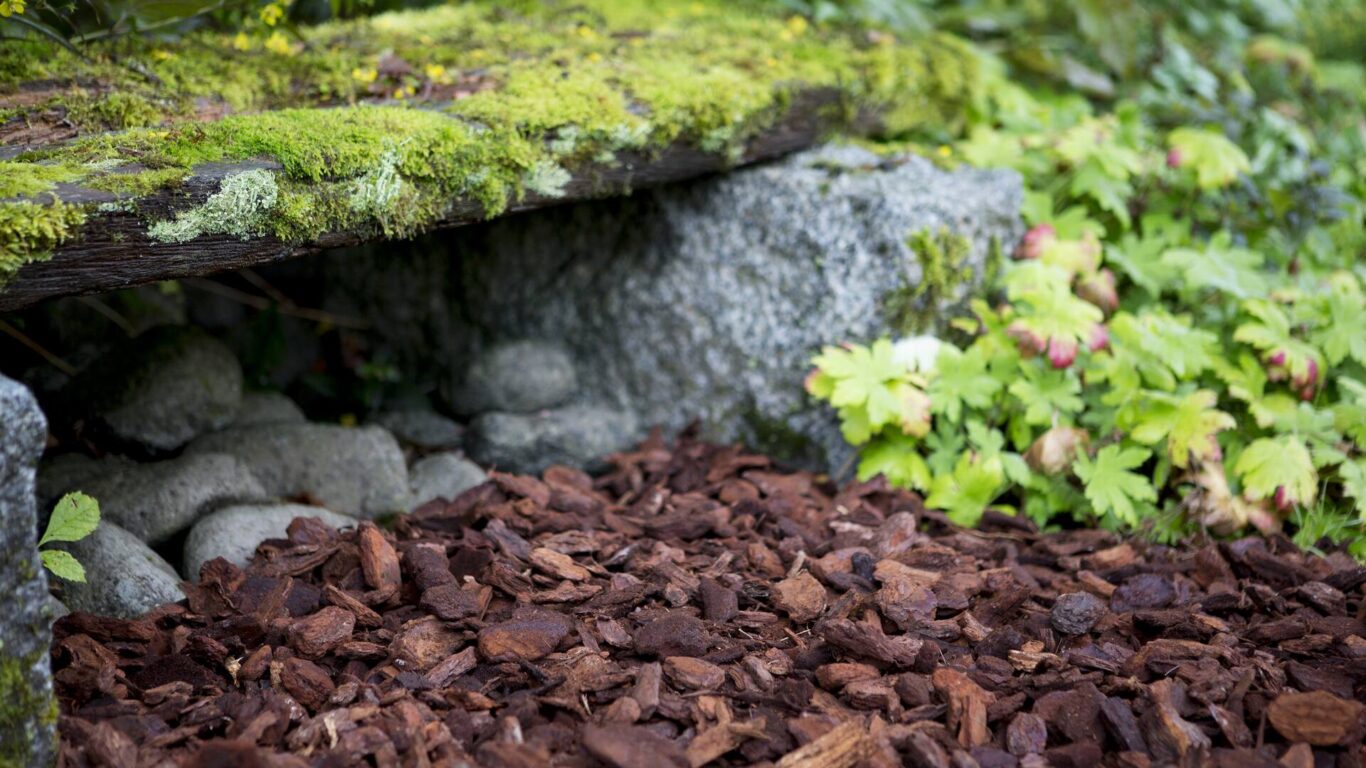Bark supports the well-being of the soil
Bark and other mulch products support the well-being of the soil
 Mulching is soil improvement where organic or inorganic material is added to the surface of planting areas. Not only does mulching have a huge number of beneficial factors for the soil, but it also has visual effects. Different types of organic materials such as bark, wood chips, grass, compost, or inorganic materials such as stones or gravel can be used as mulchings.
Mulching is soil improvement where organic or inorganic material is added to the surface of planting areas. Not only does mulching have a huge number of beneficial factors for the soil, but it also has visual effects. Different types of organic materials such as bark, wood chips, grass, compost, or inorganic materials such as stones or gravel can be used as mulchings.
What is meant by bark mulching?
Mulches are especially referring to bark mulch. Bark mulching refers to wood chips made from tree bark, for example pine or spruce bark.
Mulch improves soil moisture
The ability of bare, uncovered soil to absorb water from rainwater or irrigation weakens as it is repeatedly exposed to heat, wind, or soil compaction forces. Many have surely noticed that unexpectedly dry soil seems to absorb water poorly. In addition to this, weeds increase the amount of evaporation from the soil.
 Mulches increase the amount of moisture in the soil by promoting percolation (the absorption of rainwater into the soil) and water retention, as well as by preventing the growth of weeds. By using mulches, water which would be wasted on uncovered soil, is getting absorbed into the soil. Using the right mulch significantly reduces the need for watering in the planting area. In particular, coarse organic mulches, such as bark mulch, absorb and retain water almost like a sponge, slowly releasing it into the soil.
Mulches increase the amount of moisture in the soil by promoting percolation (the absorption of rainwater into the soil) and water retention, as well as by preventing the growth of weeds. By using mulches, water which would be wasted on uncovered soil, is getting absorbed into the soil. Using the right mulch significantly reduces the need for watering in the planting area. In particular, coarse organic mulches, such as bark mulch, absorb and retain water almost like a sponge, slowly releasing it into the soil.
The mulch maintains the optimum soil temperature
Mulches maintain a suitable temperature for the soil. In hot conditions, the mulch cools the soil, in cold conditions it keeps it warm. Maintaining the right temperature is especially important for the well-being of the roots, as especially cold temperatures can be harmful to them. Particularly hot or cold conditions cause stress, especially for young, newly transplanted seedlings that have not yet had time to take root. Establishing roots is the most important step for plant survival. In this case, the role of bark in the success of plantings is emphasized.
Bark prevents erosion
The importance of the mulch in protecting the soil is significant. Mulching can protect plants from various health problems and stress by preventing erosion and compaction caused by watering, wind, or pressure. When irrigating an uncovered planting area, the erosion caused by the flow of irrigation water is clearly noticeable in the form of water runoff and shifting of the growing medium. To prevent this phenomenon, a very thin covering is sufficient. US Department of Agriculture research according to this, placing an organic cover layer of only 1.5 cm thick can reduce erosion by up to 86%.
Organic mulch brings nutrients to the soil
Organic mulch brings nutrients to the soil. As the living matter settles, the mulch releases useful nutrients and minerals into the growing medium, thus promoting the microorganism and microbial activity of the area and the well-being of the roots. The amount of nutrients and minerals varies slightly between different mulch types. Generally speaking, the more “alive” a substance is, the richer it is in nutrients.
Mulching as weed control
In green construction, mulching can also be thought of as an effective method of weed control. In a comparison between fifteen different mulch types conducted by the University of Florida, it was found that mulch significantly reduces the growth of weeds, to put it mildly. Again, no significant differences were noticed between the different types of mulch in terms of weed prevention.
Visuality of the mulch
The mulch not only promotes the well-being of the planting area, it also adds visual value to it. By choosing covering materials, you can bring different textures and colors to the planting areas, guide pedestrians, and make the planting area look more finished compared to bare soil.
When should you apply bark mulch?
Bark is airy and heat-insulating. In the spring, the mulch is only spread when the ground has warmed up. This way you do not insulate the cold and frost in the root zone.
The airy and rough mulch breaks down more slowly and thus lasts longer. Finely divided material, such as green compost, grass clippings or similar mulches, will settle down faster and increase plant nutrition faster, but they need to be added more often.
Between trees, bushes and perennials, a mulch of 5–10 cm is sufficient. However, avoid spreading the mulch directly at the base of bushes and trees: incubating moisture on the trunk can expose a tree-stemmed plant to, for example, fungal diseases.
Over time, the organic mulch settles and adds organic matter to the soil. A suitable layer thickness can be maintained by regularly adding new mulch on top of the ground material. If you want to completely remove the mulch from the ground, it can be used, for example, in the compost to create an airy structure.
There are many benefits to using mulch
- Evaporation of moisture from the surface of the earth slows down and the need for watering decreases.
- Bark protects the soil surface from compaction and peeling caused by rain or irrigation.
- Bark protects the soil from drying out and erosion caused by the sun and wind.
- Bark increases the amount of humus in the soil, which in turn is food for soil microorganisms and improves the supply of plant nutrients.
- Bark prevents weed seeds from germinating.
- The surface of the earth looks well cared for.
This article was first published by Kekkilä Garden / Landscaping.